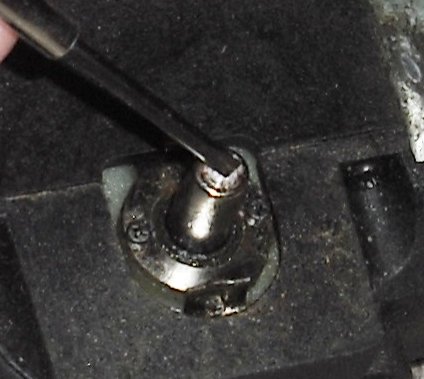Madam Chesapeake Mallet isn’t going anywhere this weekend unless I find either an Aristo axel barrel or a screw extractor for a 3mm locktited screw.


Madam Chesapeake Mallet isn’t going anywhere this weekend unless I find either an Aristo axel barrel or a screw extractor for a 3mm locktited screw.


Ohh I hate when that happens!!!
Tom,
Try this solution.
https://www.youtube.com/watch?v=gOX-BNNfTs0
I have used this heat method to remove “loctited” screws on my 1 1/2" scale steam locomotive.
Not being familiar with the loco part shown , is the cone shaped thingy screwed into plastic ?
Obviously , if it is , avoid the heat solution unless you want a warped loco .
If it isn’t , can you release the assembly by undoing the Philips screws ? That would allow you to put a drill down it and use a screw extractor with a bit of heating if necessary , without collateral damage ,but it is difficult to offer advice from the detail shown .
Mike
Mike Morgan said:
Not being familiar with the loco part shown , is the cone shaped thingy screwed into plastic ?
Obviously , if it is , avoid the heat solution unless you want a warped loco .
If it isn’t , can you release the assembly by undoing the Philips screws ? That would allow you to put a drill down it and use a screw extractor with a bit of heating if necessary , without collateral damage ,but it is difficult to offer advice from the detail shown .
Mike
Mike,
I’m assuming its a metal to metal situation. No matter what, you would always have to be judicious with the heat. It doesn’t take a lot of heat to do this. Heat guns don’t produce the very high temperatures that a torch might generate. Even so, I would put a cold water soaked rag around the area to protect any plastic in the area.
Gary ,
I had no intention of rubbishing your solution----it’s the oldest and probably best trick in the book to heat stuck joints ; I look to it as the first solution when I come across jammed bits . Ball ends stuck on steering on car ? Blowlamp . Sticky nuts ? Blowlamp . Wheels falling off my pram? Blow the lamp , Gorilla Glue would be better .
I was more concerned at the lack of information about the problem , frankly a photo such as that presented does not give sufficient information as to the solution (unless you are intimately familiar with the model ). If Tom had gone ahead even with a hair drier , he could have done more harm than good . And you may have unfairly come in for a roasting.
I think we should consider carefully what information we provide when seeking help .
Mike
I like that method better then using a torch. I have a heat gun. I have seen, in certain printer applications, where MEK (Methyl ethyl ketone) will remove locktite, but the item has to be submerged in it long enough for the MEK to soak into the locktie and soften it. With screws inside of an object, that may take a while. MEK also makes a good plastic solvent, so keep it away from any plastic you don’t want dissolved.
Tom, Navin has parts, get another from him.
Guys, the “axle” is metal, remove it from the gear and you can heat it, it’s hollow so you could work solvent in from either end.
The heat will soften the red loctite used to assemble the wheel to the axle.
Greg
Have a new axle barrel coming. Good to know Navin has them.
I usually just apply my butane torch to the screw and heat it a while. Then it backs out pretty readily. I take the drive block out of the loco first  I was surprised that this block has original screws, I figured I’d replaced them all with stainless before now. The rear block is all stainless. Stainless screws don’t strip out the Phillips head as easily.
I was surprised that this block has original screws, I figured I’d replaced them all with stainless before now. The rear block is all stainless. Stainless screws don’t strip out the Phillips head as easily.
You have to take things apart, but inside the drive block is a gear box, one for each axle. Inside that, the metal axle has 3 tiny screws holding it to a nylon gear.
FWIW: I’d use a heated pencil soldering irons tip on the screw head prior to attempting to remove the screw. Works for me every time and this method concentrates the heat in smaller area too. You need at least 425*F to soften the thread locking adhesives.
Michael
So Tom is it fixed yet?
From a post else where that Tom posted it indicated he broke off the head of the screw so all above remedies would not work. Glade he got another axle. Easy to replace. Next time hope Tom uses the heat method. Later RJD